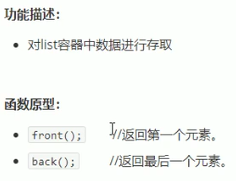list容器
1.1list基本概念
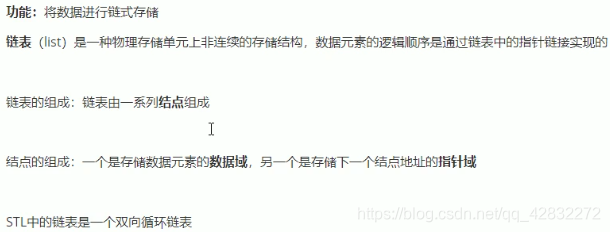

1.2list构造函数

#include"pch.h"
#include<iostream>
#include<string>
#include<opencv2/opencv.hpp>
#include<vector>
#include<algorithm> // 标准算法头文件
using namespace std;
using namespace cv;
class Person
{
public:
Person(string name, int age)
{
this->m_Name = name;
this->m_age = age;
}
string m_Name;
int m_age;
};
//list容器构造函数
void printList(const list<int>&L)
{
for (list<int>::const_iterator it = L.begin(); it != L.end(); it++)
{
cout << *it << " ";
}
cout << endl;
}
void test01()
{
//创建list容器
list<int>L1; //默认构造
//添加数据
L1.push_back(10);
L1.push_back(20);
L1.push_back(30);
L1.push_back(40);
//遍历容器
printList(L1);
//区间方式构造
list<int>L2(L1.begin(), L1.end());
printList(L2);
//拷贝构造
list<int>L3(L2);
printList(L3);
//n个elem
list<int>L4(10, 1000);
printList(L4);
}
int main()
{
test01();
system("pause");
return 0;
}
1.3list赋值和交换

#include"pch.h"
#include<iostream>
#include<string>
#include<opencv2/opencv.hpp>
#include<vector>
#include<algorithm> // 标准算法头文件
using namespace std;
using namespace cv;
//list容器赋值和交换
void printList(const list<int>&L)
{
for (list<int>::const_iterator it = L.begin(); it != L.end(); it++)
{
cout << *it << " ";
}
cout << endl;
}
void test01()
{
list<int>L1;
L1.push_back(10);
L1.push_back(20);
L1.push_back(30);
L1.push_back(40);
printList(L1);
list<int>L2;
L2 = L1;
printList(L2);
list<int>L3;
L3.assign(L2.begin(), L2.end());
printList(L3);
list<int>L4;
L4.assign(10, 100);
printList(L4);
}
void test02()
{
list<int>L1;
L1.push_back(10);
L1.push_back(20);
L1.push_back(30);
L1.push_back(40);
list<int>L2;
L2.assign(10, 100);
cout << "交换前:" << endl;
printList(L1);
printList(L2);
L1.swap(L2);
cout << "交换后:" << endl;
printList(L1);
printList(L2);
}
int main()
{
//test01();
test02();
system("pause");
return 0;
}
1.4list大小操作
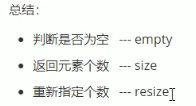
#include"pch.h"
#include<iostream>
#include<string>
#include<opencv2/opencv.hpp>
#include<vector>
#include<algorithm> // 标准算法头文件
using namespace std;
using namespace cv;
//list容器大小操作
void printList(const list<int>&l1)
{
for (list<int>::const_iterator it = l1.begin(); it != l1.end(); it++)
{
cout << *it << " ";
}
cout << endl;
}
void test01()
{
list<int>l1;
l1.push_back(10);
l1.push_back(20);
l1.push_back(30);
l1.push_back(40);
printList(l1);
//判断l1是否为空
if (l1.empty())
{
cout << "l1为空" << endl;
}
else
{
cout << "l1不为空" << endl;
cout << "l1的大小为" << l1.size() << endl;
}
//重新指定大小
l1.resize(10, 10000);
printList(l1);
l1.resize(2);
printList(l1);
}
int main()
{
test01();
//test02();
system("pause");
return 0;
}
1.5list插入和删除
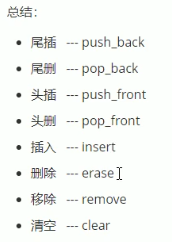
#include"pch.h"
#include<iostream>
#include<string>
#include<opencv2/opencv.hpp>
#include<vector>
#include<algorithm> // 标准算法头文件
using namespace std;
using namespace cv;
//list容器插入和删除
void printList(const list<int>&l1)
{
for (list<int>::const_iterator it = l1.begin(); it != l1.end(); it++)
{
cout << *it << " ";
}
cout << endl;
}
void test01()
{
list<int>l1;
l1.push_back(10);
l1.push_back(20);
l1.push_back(30);
l1.push_front(100);
l1.push_front(200);
l1.push_front(300);
printList(l1);
//尾删和头删
l1.pop_back();
l1.pop_front();
printList(l1);
//insert插入,使用迭代器的方式进行插入
list<int>::iterator it = l1.begin();
l1.insert(++it, 1000);
printList(l1);
//删除,使用迭代器的方式进行删除
it = l1.begin();
l1.erase(++it);
printList(l1);
//移除,与10000一样的全部删除
l1.push_back(10000);
l1.push_back(10000);
l1.push_back(10000);
l1.push_back(10000);
printList(l1);
l1.remove(10000);
printList(l1);
//清空
l1.clear();
printList(l1);
}
int main()
{
test01();
//test02();
system("pause");
return 0;
}
1.6list数据存取
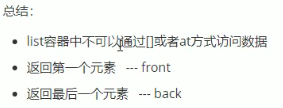
#include"pch.h"
#include<iostream>
#include<string>
#include<opencv2/opencv.hpp>
#include<vector>
#include<algorithm> // 标准算法头文件
using namespace std;
using namespace cv;
//list容器数据的存取
void test01()
{
list<int>l1;
l1.push_back(10);
l1.push_back(20);
l1.push_back(30);
l1.push_back(40);
//l1[] 不可以用[]的方式访问list容器中的元素
//l1.at(0) 不可以用at的方式访问list容器中的元素
//原因是list本质是链表,不是用连续性控件存储数据,迭代器也是不支持随机访问的
cout << "第一个元素是:" << l1.front() << endl;
cout << "第二个元素是:" << l1.back() << endl;
//验证迭代器是不支持随机访问的
list<int>::iterator it = l1.begin();
it++; //支持双向
it--;
//it = it + 1; //不支持随机访问
}
int main()
{
test01();
//test02();
system("pause");
return 0;
}
1.7list反转和排序
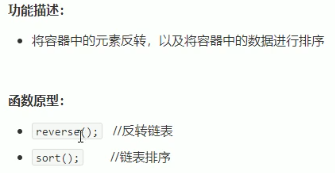
#include"pch.h"
#include<iostream>
#include<string>
#include<opencv2/opencv.hpp>
#include<vector>
#include<algorithm> // 标准算法头文件
using namespace std;
using namespace cv;
//list容器反转和排序
void printList(const list<int>&l1)
{
for (list<int>::const_iterator it = l1.begin(); it != l1.end(); it++)
{
cout << *it << " ";
}
cout << endl;
}
void test01()
{
list<int>p1;
p1.push_back(20);
p1.push_back(50);
p1.push_back(10);
p1.push_back(40);
p1.push_back(30);
cout << "反转前" << endl;
printList(p1);
//反转
cout << "反转后"<<endl;
p1.reverse();
printList(p1);
}
//排序
bool myCompare(int v1,int v2)
{
//降序 让第一个数 > 第二个数
return v1 > v2;
}
void test02()
{
list<int>p1;
p1.push_back(20);
p1.push_back(50);
p1.push_back(10);
p1.push_back(40);
p1.push_back(30);
//排序前
cout << "排序前" << endl;
printList(p1);
//排序后
cout << "排序后" << endl;
//所有不支持随机访问迭代器的容器,不可以用标准算法
//不支持随机访问迭代器的容器,内部会提供对应一些算法
//sort(p1.begin(), p1.end());
p1.sort(); //默认排序从小到大,升序
printList(p1);
p1.sort(myCompare);
printList(p1);
}
int main()
{
//test01();
test02();
system("pause");
return 0;
}
版权声明:本文为qq_42832272原创文章,遵循 CC 4.0 BY-SA 版权协议,转载请附上原文出处链接和本声明。




